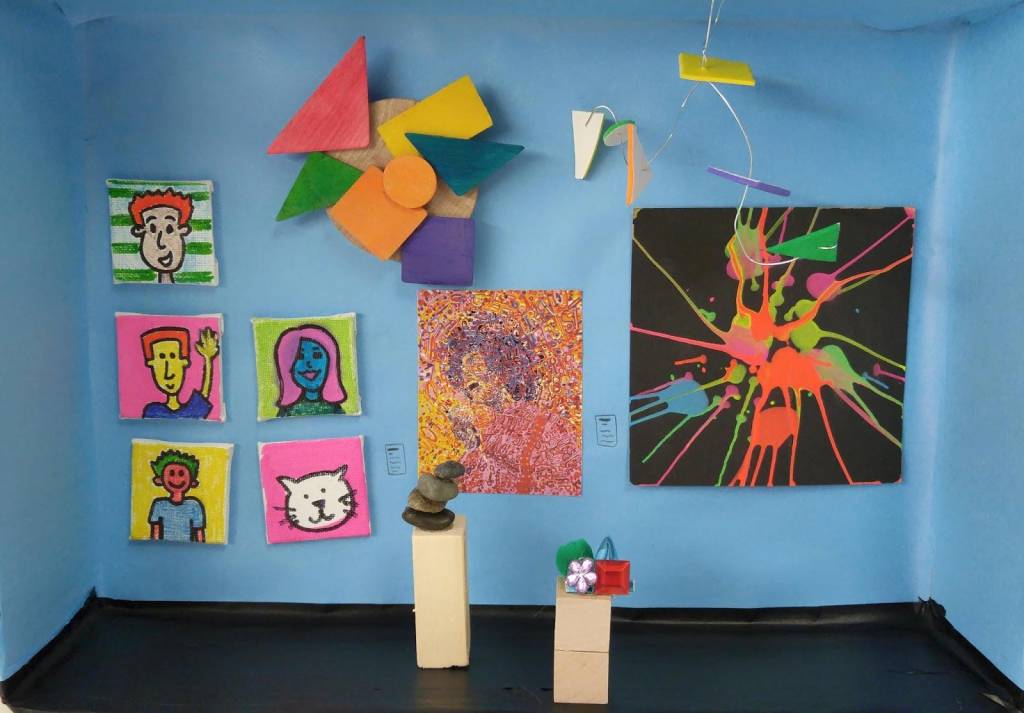This week’s #CBfromHome art activity is inspired by the salon hang in the museum’s Early American Art Gallery. Learn more about the history of salon hangs and how to create one yourself!
A “Salon-Style Hang” is a term that derived in 1667 from the French Royal Academy of Painting and Sculpture in Paris. Students would display their artwork together, but to make everything fit, all of their work was hung as closely as possible from floor to ceiling. In 1725, the exhibition moved to the Louvre, and from that point on was known as simply the Salon.
The opening of the Academy’s Salon was a critical step in the development of public museums. Previously, it had been difficult for ordinary citizens to see artwork because it was owned by private collectors, but because the Academy’s exhibitions were free, anyone could see the Salon, regardless of class, wealth, profession, or gender.
Look Closer at the Salon Hang:

- Take a look at our salon-style hang. What is your favorite artwork? Why do you like that work? How do you think it’s connected with the other artworks that surround it?
- This particular salon-style hang at Crystal Bridges was designed around a few themes. What do you think those themes are? What do you think all of these artworks have in common? What are their differences?
- Pick two artworks next to each other. Compare and contrast them! How are they similar? How are they different? How could you combine these two artworks to tell a story?
- Do you know what a curator does? An art curator helps to collect artworks and organize them for an exhibition. Our art curators here at Crystal Bridges spent many months designing the Early American Art Galleries so guests could enjoy a new way of looking at art. How would you design a museum’s gallery space? What theme would your exhibition have? What types of artwork would you include?
Activity: Design Your Own Salon Hang
Materials:
- Cardboard box
- Construction paper
- Magazines
- Coloring materials
- Glue
- Scissors
- Random materials (whatever you have) such as beads, stickers, rocks, wire, recyclable items, etc.
Instructions:
Step 1: Think about what you want your salon hang to look like. Does it have a theme? How will your art be hung?
Step 2: Grab your cardboard box! Pick what you want your wall color to be. Will it be painted? Will it have wallpaper? Glue or color how you’d like it to look.
Step 3: Once you’re done with the walls, design some tiny artwork. Create paintings or sculptures that will fit inside the box.
Step 4: Arrange your artwork! Before you glue your artwork down, think about the placement and how everything will look together.
Step 5: Finally, show off your mini salon hang! Pretend you’re a curator and display your museum to your family and friends.

Book Recommendations:
Want to learn more about museum curation and collecting artworks? Here are some books we recommend for further learning!
- My Museum by Joanne Liu
- Cabinet of Curiosities: Collecting and Understanding the Wonders of the Natural World by Gordon Grice
- Curationism: How Curating Took Over the Art World and Everything Else (Exploded Views) by David Balzer
Have fun!
Written by Dani Smith and Kim Ly, art instructors, Crystal Bridges.
Special thanks to our sponsors:
Youth and Family programming is supported in part by AMP Sign & Banner, Arthur J. Gallagher Risk Management Services, Juan, Marcy and Joaquin Camacho, The Coca-Cola Company, iHeart Media, JTH Productions, Northwest Arkansas Naturals, Pinnacle Car Services, Procter & Gamble, Gordon and Carole Segal, The Simmons Family Fund, and ViacomCBS Consumer Products.
Education and Learning is supported in part by Willard and Pat Walker Charitable Foundation, Walton Family Foundation, The Northern Trust Company, Pamela and Wayne Garrison, Doug and Shelley McMillon, Jack and Melba Shewmaker Family, Neff and Scarlett Basore, Galen and Debi Havner, Lance and Sharon Beshore, Cardinal Four Foundation, Colgate-Palmolive Company, Harry Cornell, Cox Communications, Dorothy Hurt, J.M. Smucker Company, Kimberly-Clark, Nice-Pak Products, Inc., The Russell Berrie Foundation, Stephen and Claudia Strange, Felix and Margaret Wright.




